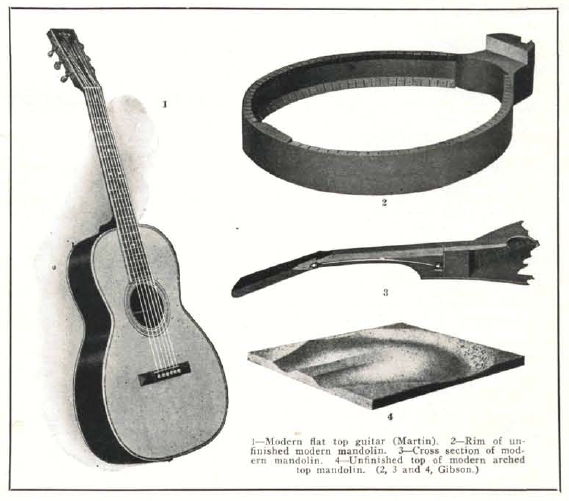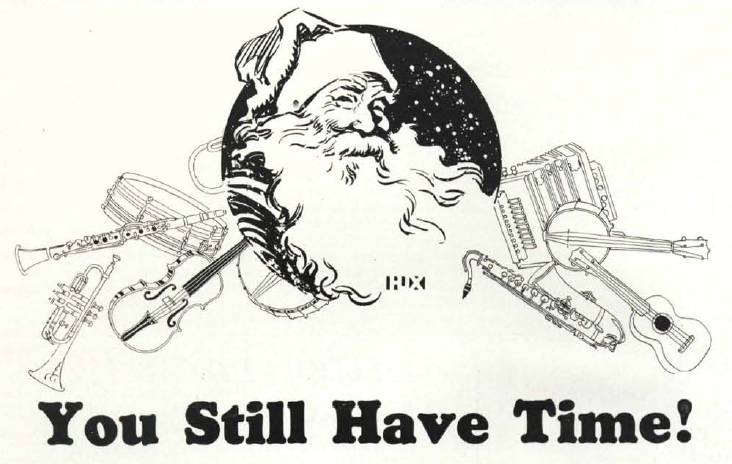| Music Trade Review |
|
Die Zeitschrift Music Trade Review ist online verfügbar: |
|
Music Trade Review - Music
Industry Magazine
Online Library: 1880 - 1933, 1940-1954 The Music Trade Review was published out of New York from 1878 until at least 1956. It apparently suspended publication with the January 1933 issue. Publication was resumed under different management sometime between 1937 and 1940. Our online library contains issues from 1880 to 1933, and from 1940 to 1954. Additional years are available for review at a number of libraries. Search www.worldcat.org for more information about the holdings of other libraries, or ask your local librarian for assistance. |
| |
| --
google Anzeige -- |
| Bitte
teilen sie diese Seite: |
|
|
Fretted InstrumentsTHEIR ORIGIN, DEVELOPMENT and MARKETINGSecond of a Series of Articles on Fretted InstrumentsBy LLOYD LOARIn order to appreciate the possibilities of what an instrument can do, it is wise to first obtain a general idea of how it does it. So we will devote a little time to the acoustics of fretted instruments, not as scientists, however, but as merchandisers and players of these instruments. In general, all stringed instruments produce tone in the same way. First, the string vibrates a certain number of times per second, this vibration rate being controlled by the length, tension, diameter and material of the string. String vibration, by the way, is a complex performance. When we hear one tone in a guitar, for instance, a great many vibration rates are represented in it. These components of tone are known as "partials," or fundamental and overtones, and have somewhat the same relation to the resulting tone as the seven primary colors do to the ray of white light which they compose. The lowest in pitch of these partials, also known as the fundamental or first partial, determines the pitch of the tone we hear, while the rest of the partials determine its color or character. These partials have a definite relationship to each other, governed by the ratio of whole numbers— that is, if the first partial has a vibration frequency of 100 per second, the second one would have a frequency of 200, the third of 300, and so on. If the partials present went as far as the sixteenth, it would have a frequency of 1,600 per second. The percentage of each of the partials to the whole tone is what determines the color of the tone; and if it were possible to produce a mandolin, a banjo, a violin, a piano and a saxophone, each of which produced a tone with exactly the same number and ratio of partials, they would all sound exactly alike. This, of course, is not possible. When a string is stopped by a metal fret at one end, a bridge of dense material at the other, and is vibrated by being picked, a certain number and ratio of partials is encouraged that gives what has come to be known as fretted instrument or plucked string tone. Improvement in the instrument's design may greatly improve the quality and increase the quantity of tone produced, but the original number and ratio of partials will be adhered to closely enough so that the tone is still fretted instrument tone. The bridge acts as a lever to turn these string vibrations downward into the sound- board and also to increase their strength by reducing their amplitude, concentrating them —in other words. The soundboard or top is pushed down by each string vibration through the bridge, and pushes itself back and a little beyond the position it occupies when at rest, through its inherent elasticity. This continues as long as the string vibrates. This soundboard and string motion reaches the back through the rim and the block to which the tailpiece is fastened, the back responds and the whole body of the instrument vibrates as a unit. The air contained in the body or box is also forced to vibrate at the same rates as the strings and the body of the instrument, As the top and back move into and then away from the outside air they produce the series of condensations and rarefactions known as a sound wave, the pulsating air inside the body contacts with the outside air through the soundholes, adds its bit to the sound-wave pattern, and the total result is the tone we hear from the instrument. In different designs of instruments the top, back and air chamber favor certain partials at the expense of others, so the tone of these different designs is not equally good. In some of them the fundamental or first partial is neglected and the tone sounds thin or shrill. In others the fundamental may be favored too much and the tone lacks vitality. Many variations arc possible. The banjo family has only a vibrating top or calfskin head; the back, or resonator, and rim not vibrating in a way that produces tone. But the head is so light in weight and its response to the string can be so effectively speeded up by tension on the head through the tension hooks, that it vibrates violently enough to make up for this. Fretted instrument tone is characterized by an impact or comparatively powerful tone as the string is struck and a rapid diminution of intensity until the tone ceases. The tone sustains an appreciable length of time, but if a long-sustained tone of considerable power is desired the string must be struck again and again as rapidly as possible by the pick or the finger. And the more powerful the initial tone produced, characteristic of a certain type of instrument, the more quickly it dies away. This is true of any instrument; if the instrument has been designed so that all the vibratory energy available is used at once the tone is very powerful, if it is spread out over several seconds of time the tone is correspondingly weaker. Wind instruments, the strongestvoiced music-makers we have, will not sustain their tone at all after the lips or air stream have ceased to vibrate the tone-producing air column. Consequently, the more sustained tone of a mandolin or guitar means a weaker tone than the shorter banjo tone. The tone of fretted instruments, musically considered, is decidedly pleasing. It has a piquancy and color that appeals to both trained and untrained ears when it is presented with adequate technical and emotional equipment. And, furthermore, the particular tone colors and effects they can contribute to the world of music are unique in themselves and can be supplied by no other instrument or family of instruments. This is so true that many great composers, men whose whole souls were devoted to the adequate recreation of their genius-inspired visions in tone, used fretted instruments in many of their great compositions. Paganini at one time considered dropping the violin for the guitar and he wrote several quartets in which the guitar was included; Berlioz, known as the father of the modern orchestra, was able to play only the guitar; Verdi included mandolins in his instrumentation for the "Othello" music; Wolf- Ferrari did likewise in "Jewels of the Madonna"; Beethoven, Gluck, Rossini, Mozart, Thomas and others of like eminence wrote for these instruments; and Harling in his successful modern opera, "The Light of St. Agnes," gives the tenor banjo an important part. In commenting on a recent concert of Andres Segovia, one of the great modern guitarists, Deems Taylor says in McCall's Magazine: "The guitar can be an instrument of extraordinary variety and beauty, capable of commanding the respect of the most uncompromising of musicians." The significance of this is that the greatest connoisseurs of tone values have found in fretted instruments tone effects and colors that they liked; and, after all, a musical instrument must ultimately survive and flourish, if it does, on the musical value of the tone and the effects peculiar to it. If it has this value it will persist through every imaginable vicissitude. Changes in its construction will be inspired that will augment its particular tonal values and musical effec effectiveness, and it will eventually secure and hold such a large share of popular favor that its high standing becomes permanent.
It is only a matter of time until the fretted instruments have an important part in every symphonic and operatic orchestra and are considered a necessity in any musical instrument activity. Their distinctive and valuable tone color, their wide range of effects peculiar to themselves, and the unique advantages they offer to all factors in the world of music activity make this conclusion inevitable. These possibilities will be covered in detail later on; the point to be emphasized here is the extraordinary vitality displayed by fretted instrument tone—a vitality that has kept it alive over thousands of years; and the value this sort of tone has had for writers of music whose sense of such values was and is very keen. The trend of modern music and the Americanized improved editions of these instruments introduced in the last score or so of years can only reinforce our conclusion as to their ultimate recognized importance.  1—Modern flat top guitar (Martin).2—Rim of unfinished modern mandolin.3—Cross section of modern mandolin.4—Unfinished top of modern arched top mandolin. (2, 3 and 4, Gibson.)Quelle / source: |
You Still Have Time! 
Source: http://mtr.arcade-museum.com/MTR-1929-88-29/94/ Buescher Band Instrument Co. - 3 Beautiful New Models |
>>> Zurück zum Inhalt - Back to the Contents <<< |
| Wenn
sie diese Seite
ohne Navigationsleiste angezeigt bekommen, dann klicken sie hier um die MandoIsland Homepage zu öffen: |
 |